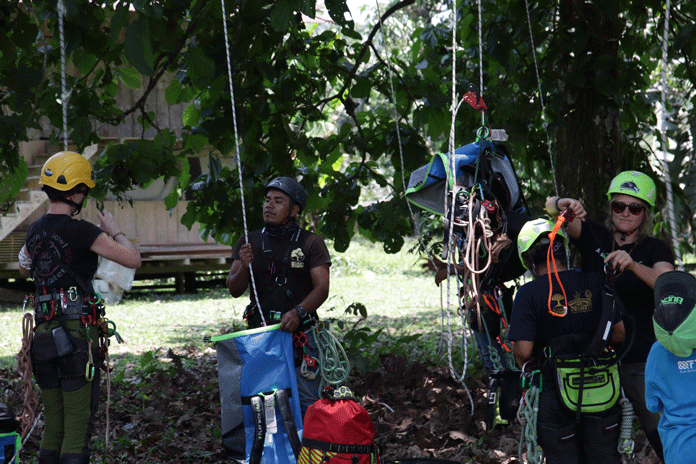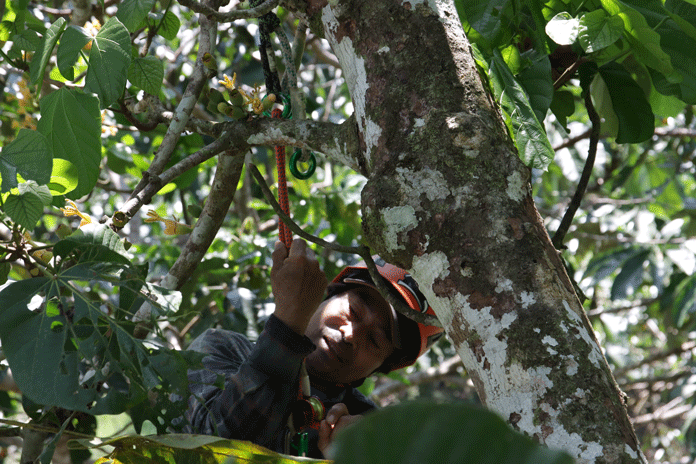An Expedition to Ecuador

We watched the immense downpour from the shelter of our Maloka, a traditional open-sided hut in which we were being accommodated during our time in the jungle. Barely able to hear each other over the sound of rain hammering against the metal roof, we set about capturing footage until the incessant roar above our heads had dissipated into little more than a light percussion, giving rhythm to the re-emerging sounds of the rainforest. While the expedition team were intent on remaining inside until the remnants of rain had passed, some members of the family who were hosting us had ventured outside to resume the tasks which the downpour had interrupted. . .
. . . A light drizzle remained when we heard an excited commotion from outside. The team hurried out, Bex and I taking a second to grab a camera and a tarpaulin before following behind to film whatever it was that had garnered such interest. “A sloth!” one of the team called to us, their voice softened but audible, pointing up into the canopy where a dark shape hung amongst the branches. From then the group were quiet, aware that more commotion might prompt the sloth to move further amongst the branches and out of view. I set myself the task of suspending the tarpaulin above Bex as she positioned the camera towards the canopy, for fear that what remained of the rain would distort the lens and ruin such a rare shot. Amongst the branches, and just visible on the camera’s tiny screen, the sloth began to roll its head back. The silhouette took shape as it reached out a lazy arm and crawled its way into the depths of the foliage. Our hosts, Antonio and Lily, would later tell us how rare it is to see a sloth so close to home, a sign that the spirits of the forest were with us here.
Ten days earlier we had been contending with bright morning sun in the heart of Ecuador’s capital city, Quito. Not yet adapted to the altitude we could feel its effects on our legs and arms as we hauled the heavy bags of arboriculture gear out of our hostel and onto the pavement next to the bus. We then watched on as the bus crew, a driver and three young men, passed the bags up and onto the roof, lashing them down ready for the journey ahead. The bus was comfortable but small, and while the team could all fit inside with some personal bags, the majority of the kit had to go up top. Bex and I had taken our camera inserts out, allowing the rucksacks to be crammed onto the roof but unwilling to part with our camera gear – we were packing light, so if the cameras were to be lost or damaged we might find ourselves filming our documentary with our phones.
After twelve hours on the road, delayed for a short time while the crew repaired the engine mid-journey, we finally reached the Aguarico River. By now it was past dark and above us countless stars spread across the sky, hindered only by sparse pools of light which lit the small port village in which we had arrived. Antonio and Lily had been waiting for our arrival, and helped us carry the bags of equipment off the bus and onto their motorised canoes before setting off upriver into the Siekoya Remelino territory. The river was the lifeline of the communities dotted along its banks, the Siekoya being one of many, and while it ran deep within the Amazon basin it lay at the very edge of the ever-receding Amazon rainforest.
Big Canopy Campout had organised this expedition after three years of collaborating and fundraising with the SËRA Foundation, a group comprised of young forest defenders of indigenous Siekopai nationality. This collaboration had progressed and developed through these years, ultimately flourishing into this initiative; bringing rope access techniques and equipment to the Siekoya community, creating an exciting new opportunity to further utilise their traditional knowledge into forms of income. Bex and I had an important part to play, documenting this particular initiative as part of the community’s wider struggle to retain their land and culture for generations to come. Working in tandem with the objectives of the expedition was the goal to help bring their incredible story of resistance to an international audience.


Given the time of year we had packed for rain, ensuring that everyone had wellies and a poncho at hand, and that our camera gear had numerous ways of being kept from getting wet. The first handful of days with the Siekopai, however, were hot and dry, the earth parched and cracked in want of rain. The Siekoya, surprised at the unseasonable heat, waited patiently for the seasonal change, and our expedition team - especially the Belgians and Scots - were most definitely ready for rain. The tarps and ponchos which we had packed for humidity and downpours were instead laid out on the ground to help keep our gear from getting caked in dust, and the rain covers of our rucksacks quickly turned a dirty brown colour, the loose earth clinging to everything it came into contact with. Even the village dogs, bounding with excitement, would leave dirty paw prints over our clothes and bags as they clambering over us to investigate our cameras and the fluffy mics that wobbled invitingly on top.
The change of seasons came one evening as we made our way back from the village. The cool breeze created by the movement of the canoe was very welcome and we took relief in the fading sunlight. Distant at first, a reluctant rumble of thunder grew into an ominous growl, rolling across the treetops and drowning out the sounds of the jungle. As the sky darkened further we saw flashes, circling around us in a distant, frenzied dance, prompting Antonio to hurry the canoe along the river and up to the riverbank. While laying down to sleep that night the thunder had been and gone, replaced instead by the hammering of rain upon the tin roof above us. The sound consumed the hut, but we could finally enjoy our first night of cool air and the promise of a reprieve from the heat in the days ahead. When morning came the rain had passed and the familiar dawn chorus burst from the trees. Around the Maloka mist loomed in patches, dissipating slowly in the thin morning light, and while the air had the appearance of being thick and heavy, it felt cool and fresh.
Throughout our time spent with the community we found ourselves exposed to a seemingly endless stream of knowledge about the rich ecosystem that surrounded us. Even in the area around our Maloka, Antonio and Lily would tell us about a whole variety of plants, from the cultural significance of the immense Ceibo trees which burst out above the canopy, to the smallest of plants which the Siekopai would use as an anti-venom, growing right next to where we hung our washing out to dry. Likewise, the more we interviewed and chatted with members of the Siekoya community the more we came to understand that life in the jungle, while beautiful and awe-inspiring, was not without its challenges. The dense jungle around the village seems to overflow with the sound of animal life. Birds flit from tree to tree, often venturing into the village, and from the river we could see monkeys at home amongst the trees. At the same time we became aware of the biting insects and threat of snakes which was simply part of daily life in the village, along with the stories of jaguars stalking through the forest from time to time. There are modern challenges here too. The river which connects the community to the outside world, while expertly navigated by Siekoya men and women, now carries increasing levels of contamination from the oil fields upstream. Some of these challenges are overcome by the Siekopai without a second thought, utilising the knowledge passed down through countless generations, while the more modern challenges require some innovative thinking. During our time spent in the jungle, it was clear to us that the Siekopai did not choose to remain here because life was easy or idyllic, but rather because it was their home, the only place where their rich indigenous culture could exist.

One morning, earlier than usual, we were invited to join the family and try a drink which is integral to Siekopai culture, Yokó. We could already hear movement and chatter downstairs as preparation began, and with our cameras stashed right next to where we slept we could quickly grab fresh batteries and attach our mics before hurrying down in time for this morning tradition. As we joined the group, Lily’s father, Bartollo, greeted us happily, gesturing to sit on the wooden floor in front of him. At his feet lay a bowl made from a coconut shell and a small knife, a freshly cut stick was propped up by his side. Dressed in his traditional orange garment he drew the knife across the bark, gathering the strips and soaking them in the bowl to prepare the drink. Every movement was familiar to him, and yet he conducted himself with a sense of care and reverence that appeared to be inseparable from the process, not one step was rushed.
Later that day, once Bex and I had made our way to the village and gotten our bags and camera gear ready, we saw Bartollo once again. He was no longer dressed in his pristine Siekopai attire, but he instead sported well-worn trainers, jeans and a T-shirt, strapping on his helmet and joining the group for the next stage of the tree climbing training. There was a noticeable change in how he interacted with the world around him, almost as if the traditional attire he wore that morning had carried with it the weight of Siekopai heritage. Now changed into non-traditional, practical clothing he instead carried a sense of action, looking up and around with enthusiasm and interest, ascending into the foliage with confidence after only a few days of instruction.

Bartollo, much like other proud members of the Siekopai nationality, was organised and engaged when there was work to be done, but still integrated a genuine reverence for traditions and values into every aspect of village life. This pride and reverence is a foundation upon which they continue their fight to preserve their land and culture, engaging enthusiastically with certain tools which the Western world has to offer, while never forgetting who they are and the importance of indigenous wisdom in an ever-changing world.



